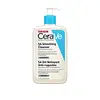What's inside
What's inside
 Key Ingredients
Key Ingredients

 Benefits
Benefits

 Concerns
Concerns

 Ingredients Side-by-side
Ingredients Side-by-side

Water
Skin ConditioningCocamidopropyl Betaine
CleansingGlycerin
HumectantSodium Lauryl Sulfoacetate
CleansingPEG-120 Methyl Glucose Dioleate
EmulsifyingSodium Chloride
MaskingDisodium Cocoamphodiacetate
CleansingPolysorbate 20
EmulsifyingSorbitan Sesquicaprylate
Skin ConditioningPhenoxyethanol
PreservativeAcrylates/Steareth-20 Methacrylate Copolymer
Parfum
MaskingCalcium Caseinate
Skin ConditioningSodium Sulfate
1,2-Hexanediol
Skin ConditioningCaprylyl Glycol
EmollientSodium Lauroyl Oat Amino Acids
CleansingSodium PCA
HumectantSodium Hydroxide
BufferingDisodium EDTA
Quercus Robur Bark Extract
AstringentMentha Piperita Oil
MaskingCaramel
Cosmetic ColorantHydrolyzed Lupine Protein
Skin ConditioningAlpha-Isomethyl Ionone
PerfumingHydrolyzed Wheat Protein
Skin ConditioningMentha Viridis Leaf Oil
AstringentTropolone
Skin ConditioningTetrasodium EDTA
Sodium Benzoate
MaskingEthylhexylglycerin
Skin ConditioningTocopherol
AntioxidantPotassium Sorbate
PreservativeWater, Cocamidopropyl Betaine, Glycerin, Sodium Lauryl Sulfoacetate, PEG-120 Methyl Glucose Dioleate, Sodium Chloride, Disodium Cocoamphodiacetate, Polysorbate 20, Sorbitan Sesquicaprylate, Phenoxyethanol, Acrylates/Steareth-20 Methacrylate Copolymer, Parfum, Calcium Caseinate, Sodium Sulfate, 1,2-Hexanediol, Caprylyl Glycol, Sodium Lauroyl Oat Amino Acids, Sodium PCA, Sodium Hydroxide, Disodium EDTA, Quercus Robur Bark Extract, Mentha Piperita Oil, Caramel, Hydrolyzed Lupine Protein, Alpha-Isomethyl Ionone, Hydrolyzed Wheat Protein, Mentha Viridis Leaf Oil, Tropolone, Tetrasodium EDTA, Sodium Benzoate, Ethylhexylglycerin, Tocopherol, Potassium Sorbate
Water
Skin ConditioningSodium Lauroyl Sarcosinate
CleansingCocamidopropyl Hydroxysultaine
CleansingGlycerin
HumectantNiacinamide
SmoothingGluconolactone
Skin ConditioningSodium Methyl Cocoyl Taurate
CleansingPEG-150 Pentaerythrityl Tetrastearate
EmulsifyingCeramide NP
Skin ConditioningCeramide AP
Skin ConditioningCeramide EOP
Skin ConditioningCarbomer
Emulsion StabilisingCalcium Gluconate
HumectantSalicylic Acid
MaskingSodium Benzoate
MaskingSodium Lauroyl Lactylate
EmulsifyingCholesterol
EmollientPhenoxyethanol
PreservativeDisodium EDTA
Tetrasodium EDTA
Hydrolyzed Hyaluronic Acid
HumectantPhytosphingosine
Skin ConditioningXanthan Gum
EmulsifyingEthylhexylglycerin
Skin ConditioningWater, Sodium Lauroyl Sarcosinate, Cocamidopropyl Hydroxysultaine, Glycerin, Niacinamide, Gluconolactone, Sodium Methyl Cocoyl Taurate, PEG-150 Pentaerythrityl Tetrastearate, Ceramide NP, Ceramide AP, Ceramide EOP, Carbomer, Calcium Gluconate, Salicylic Acid, Sodium Benzoate, Sodium Lauroyl Lactylate, Cholesterol, Phenoxyethanol, Disodium EDTA, Tetrasodium EDTA, Hydrolyzed Hyaluronic Acid, Phytosphingosine, Xanthan Gum, Ethylhexylglycerin
 Reviews
Reviews

Ingredients Explained
These ingredients are found in both products.
Ingredients higher up in an ingredient list are typically present in a larger amount.
Disodium EDTA plays a role in making products more stable by aiding other preservatives.
It is a chelating agent, meaning it neutralizes metal ions that may be found in a product.
Disodium EDTA is a salt of edetic acid and is found to be safe in cosmetic ingredients.
Learn more about Disodium EDTAEthylhexylglycerin (we can't pronounce this either) is commonly used as a preservative and skin softener. It is derived from glyceryl.
You might see Ethylhexylglycerin often paired with other preservatives such as phenoxyethanol. Ethylhexylglycerin has been found to increase the effectiveness of these other preservatives.
Glycerin is already naturally found in your skin. It helps moisturize and protect your skin.
A study from 2016 found glycerin to be more effective as a humectant than AHAs and hyaluronic acid.
As a humectant, it helps the skin stay hydrated by pulling moisture to your skin. The low molecular weight of glycerin allows it to pull moisture into the deeper layers of your skin.
Hydrated skin improves your skin barrier; Your skin barrier helps protect against irritants and bacteria.
Glycerin has also been found to have antimicrobial and antiviral properties. Due to these properties, glycerin is often used in wound and burn treatments.
In cosmetics, glycerin is usually derived from plants such as soybean or palm. However, it can also be sourced from animals, such as tallow or animal fat.
This ingredient is organic, colorless, odorless, and non-toxic.
Glycerin is the name for this ingredient in American English. British English uses Glycerol/Glycerine.
Learn more about GlycerinPhenoxyethanol is a preservative that has germicide, antimicrobial, and aromatic properties. Studies show that phenoxyethanol can prevent microbial growth. By itself, it has a scent that is similar to that of a rose.
It's often used in formulations along with Caprylyl Glycol to preserve the shelf life of products.
Sodium Benzoate is a preservative. It's used in both cosmetic and food products to inhibit the growth of mold and bacteria. It is typically produced synthetically.
Both the US FDA and EU Health Committee have approved the use of sodium benzoate. In the US, levels of 0.1% (of the total product) are allowed.
Sodium benzoate works as a preservative by inhibiting the growth of bacteria inside of cells. It prevents the cell from fermenting a type of sugar using an enzyme called phosphofructokinase.
It is the salt of benzoic acid. Foods containing sodium benzoate include soda, salad dressings, condiments, fruit juices, wines, and snack foods.
Studies for using ascorbic acid and sodium benzoate in cosmetics are lacking, especially in skincare routines with multiple steps.
We always recommend speaking with a professional, such as a dermatologist, if you have any concerns.
Learn more about Sodium BenzoateTetrasodium EDTA is the salt formed from neutralizing ethylenediamine tetraacetic acid with sodium hydroxide. It is a chelating agent and used to prevent metal ions from binding to other ingredients. This helps keep the product and ingredients stable.
Tetrasodium EDTA comes as a white solid and is soluble in water.
Water. It's the most common cosmetic ingredient of all. You'll usually see it at the top of ingredient lists, meaning that it makes up the largest part of the product.
So why is it so popular? Water most often acts as a solvent - this means that it helps dissolve other ingredients into the formulation.
You'll also recognize water as that liquid we all need to stay alive. If you see this, drink a glass of water. Stay hydrated!
Learn more about Water